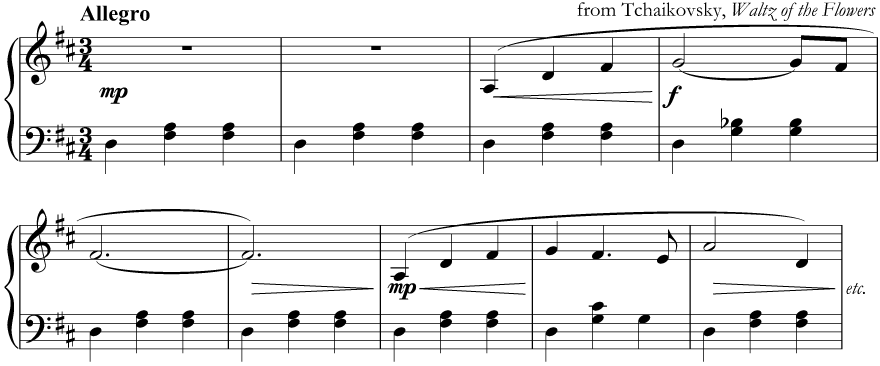Time signatures
In this guide...
Key terms:
Subscription required!
To view the complete study guide, you will need a valid subscription. Why not subscribe now?
Already have a subscription? Make sure you login first!
Introduction
We have so far looked at the concept of a bar and the beats within the bar. All the examples so far have had 4 beats in a bar, but now we'll see how a bars can contain different number of beats.
Common time
All the examples so far have been written using Common Time, with 4 beats to a bar. Recall how we count the the number of beats in a bar:
 Counting 1, 2, 3, 4, 1, 2, 3, 4
Counting 1, 2, 3, 4, 1, 2, 3, 4Time signature
The example above has a key signature of one flat (F major), and next to the key signature is a "C" symbol. This is the time signature. It is written at beginning of the first stave of music, but unlike the key signature, it is not repeated on each system.
An alternative
Most time signatures are not designated by a single symbol but by two numbers, one on top of the other, somewhat like a fraction; for example: 4/4.
The lower number refers to the type of beat. "4" stands for a crotchet beat (think "quarter note", or "1/4" note), while 8 stands for a quaver beat (think "eighth note") and so on.
The upper number refers to the number of these beats in the bar.
Therefore an alternative time signature for C, is 4/4: both indicate that each bar contains 4 beats, each of one crotchet.
Here is the same example again, using 4/4:
 The same again, using 4/4
The same again, using 4/4Other time signatures
Using this system, we can create other time signatures. For instance, we can keep the crotchet beat (so the lower number will still be 4, but have 2 or 3 beats in a bar instead of 4. When there are 2 crotchets, the time signature is 2/4; and when there are 3 crotchets in a bar it is 3/4.
The table below shows how lots of different time signatures are possible using this basic idea. We'll look at some interesting aspects of some of these time signatures in due course.
| Time signature | Construction |
|---|---|
 |  + +  |
 |  + +  + +  |
 |  + +  + +  + +  |
 |  + +  |
 |  + +  + +  |
 |  + +  + +  + +  |
 |  + +  |
 |  + +  + +  |
 |  + +  + +  + +  |
Strong and weak beats
You might remember that earlier, we said that the first beat in a bar is the most important.
This is true of all time signatures and has a long history dating back to the ancient Greeks, and corresponds closely to spoken language in which some syllables and stressed and others are weak. Perhaps you have considered this in English class?
Just like in poetry, the patterns of strong and weak beats (syllables) occur either in groups of two or three. That is, there may be one or two weak beats for every strong one.
In 2/4, there is a simple alternation between strong and weak beats: strong / weak, strong / weak, and so on.
In 3/4, each strong beat is followed by two weak beats: strong / weak / weak, strong / weak / weak, and so on - think of the Oom-pah-pah of a waltz, for instance. Each first beat is a heavy bass note, followed by two weak beats.
Here is an example from a famous waltz by Tchaikovsky:
 from Tchaikovsky, Waltz of the Flowers: with a "strong / weak / weak" pattern in the accompaniment
from Tchaikovsky, Waltz of the Flowers: with a "strong / weak / weak" pattern in the accompanimentIn 4/4
This idea is slightly more complicated in four-beat time signatures, such as 4/4.
It is useful to think of 4/4 as a combination of two 2/4 bars: strong / weak / strong / weak – but with the first strong beat being even more important.
The result is therefore: strong / weak / medium / weak.
Whole bar rests
Now that we have encountered bars of different lengths, we need to consider how to write a whole bar rest.
Confusingly, this is not simply done with a rest of the full bar's length, but rather with the semibreve rest symbol. This is the case even though most time signatures are not exactly a semibreve long - some are longer, some are shorter.
 All of these time signatures use the same symbol for a complete bar's rest
All of these time signatures use the same symbol for a complete bar's restIn fact, it is true of all time signatures up to 4/2 (four beats, each of a minim in duration) at which point a special "breve" rest is used, corresponding exactly to the length of that bar. You'll come across this again in More notes and rests.
Read more...
With a subscription to Clements Theory you'll be able to read this and dozens of other study guides, along with thousands of practice questions and more! Why not subscribe now?
Revision
Are you sure you've understood everything in this study guide? Why not try the following practice questions, just to be sure!